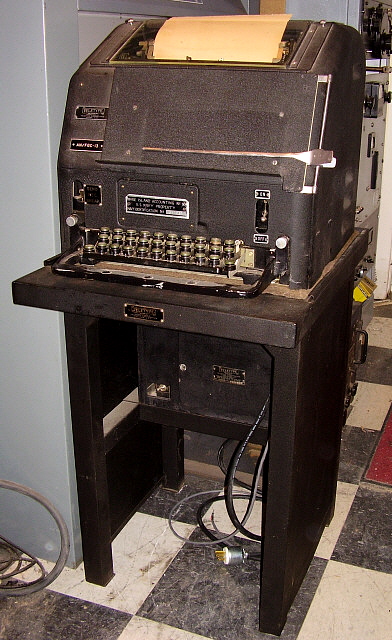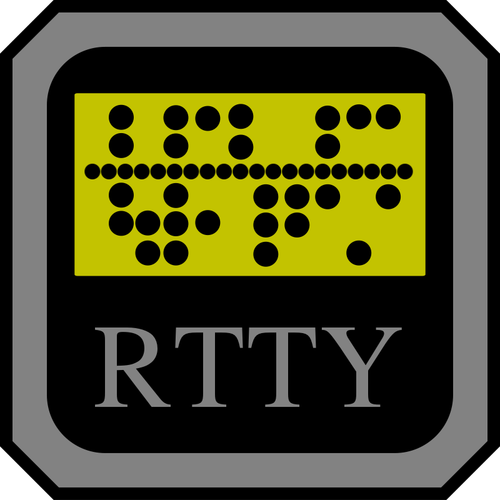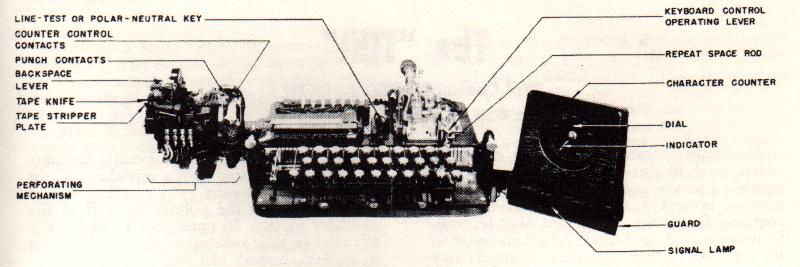

These are stand-alone UART devices, similar to computer serial port peripherals.

Special integrated circuits have been developed for this function, for example the Intersil 64. With electromechanical teleprinters, these functions required complicated electromechanical devices, but they are easily implemented with standard digital electronics using shift registers. When a sequence of start bit, 5 data bits and stop bit arrives at the input of the teleprinter, it is converted to a 5-bit word and passed to the printer or VDU. The teleprinter converts it to serial format and transmits a sequence of a start bit (a logical 0 or space), then one after the other the 5 data bits, finishing with a stop bit (a logical 1 or mark, lasting 1, 1.5 or 2 bits). When a key of the teleprinter keyboard is pressed, a 5-bit character is generated. When no traffic is passed, the line idles at the "mark" state. The line output of a teleprinter can be at either digital logic levels (+5 V signifies a logical "1" or mark and 0 V signifies a logical "0" or space) or line levels (−80 V signifies a "1" and +80 V a "0"). Alternative output devices are tape perforators and computer storage media. An alternative input device is a perforated tape reader and, more recently, computer storage media (such as floppy disks). The teleprinter includes a keyboard, which is the main means of entering text, and a printer or visual display unit (VDU). The word Teletype was a trademark of the Teletype Corporation, so the terms "TTY", "RTTY", "RATT" and "teleprinter" are usually used to describe a generic device without reference to a particular manufacturer.Įlectromechanical teleprinters are heavy, complex and noisy, and have largely been replaced with electronic units. The Teletype or teleprinter is an electromechanical or electronic device. The military used frequency shift keying technology and this technology proved very reliable even over long distances.įrom the 1980s, teleprinters were replaced by computers running teleprinter emulation software.Ī radioteletype station consists of three distinct parts: the Teletype or teleprinter, the modem and the radio. The Navy called radioteletype RATT (Radio Automatic Teletype) and the Army Signal Corps called radioteletype SCRT, an abbreviation of Single-Channel Radio Teletype. The US Military used radioteletype in the 1930s and expanded this usage during World War II. Commercial RTTY systems were in active service between San Francisco and Honolulu as early as April 1932 and between San Francisco and New York City by 1934. An early implementation of the Radioteletype was the Watsongraph, named after Detroit inventor Glenn Watson in March 1931. Later that year, the Radio Corporation of America successfully tested printing telegraphy via their Chatham, MA radio station to the R.M.S. The US Department of the Navy successfully tested printing telegraphy between an airplane and ground radio station in August 1922. Radioteletype evolved from these earlier landline teleprinter operations.

Teleprinter system design was gradually improved until, at the beginning of World War II, it represented the principal distribution method used by the news services.
RTTY MACHINE CODE
Émile Baudot designed a system using a five unit code in 1874 that is still in use today. Landline teleprinter operations began in 1849 when a circuit was put in service between Philadelphia and New York City. In some applications, notably military and government, radioteletype is known by the acronym RATT (Radio Automatic Teletype).
RTTY MACHINE SOFTWARE
The term radioteletype is used to describe both the original radioteletype system, sometimes described as " Baudot", as well as the entire family of systems connecting two or more teleprinters or PCs using software to emulate teleprinters, over radio, regardless of alphabet, link system or modulation.

From the 1980s, teleprinters were replaced by personal computers (PCs) running software to emulate teleprinters. The US military used radioteletype in the 1930s and expanded this usage during World War II. Later that year, the Radio Corporation of America successfully tested printing telegraphy via their Chatham, Massachusetts, radio station to the R.M.S. The US Navy Department successfully tested printing telegraphy between an airplane and ground radio station in 1922. Radioteletype evolved from earlier landline teleprinter operations that began in the mid-1800s. Radioteletype ( RTTY) is a telecommunications system consisting originally of two or more electromechanical teleprinters in different locations connected by radio rather than a wired link.


 0 kommentar(er)
0 kommentar(er)
